Books by Giorgio Tagliaferro

Over the past twenty years or so it has finally been understood that Jacopo Tintoretto (1518/19-1... more Over the past twenty years or so it has finally been understood that Jacopo Tintoretto (1518/19-1594) is an old master of the very highest calibre, whose sharp visual intelligence and brilliant oil technique provides a match for any painter of any time. Based on papers given at a conference held at Keble College, Oxford, to mark the quincentenary of Tintoretto’s birth, this volume comprises ten new essays written by an international range of scholars that open many fresh perspectives on this remarkable Venetian painter. Reflecting current ‘hot spots’ in Tintoretto studies, and suggesting fruitful avenues for future research, chapters explore aspects of the artist’s professional and social identity; his graphic oeuvre and workshop practice; his secular and sacred works in their cultural context; and the emergent artistic personality of his painter-son Domenico. Building upon the opening-up of the Tintoretto phenomenon to less fixed or partial viewpoints in recent years, this volume reveals the great master’s painting practice as excitingly experimental, dynamic, open-ended, and original.

Over the past twenty years or so it has finally been understood that Jacopo Tintoretto (1518/19-1... more Over the past twenty years or so it has finally been understood that Jacopo Tintoretto (1518/19-1594) is an old master of the very highest calibre, whose sharp visual intelligence and brilliant oil technique provides a match for any painter of any time. Based on papers given at a conference held at Keble College, Oxford, to mark the quincentenary of Tintoretto’s birth, this volume comprises ten new essays written by an international range of scholars that open many fresh perspectives on this remarkable Venetian painter. Reflecting current ‘hot spots’ in Tintoretto studies, and suggesting fruitful avenues for future research, chapters explore aspects of the artist’s professional and social identity; his graphic oeuvre and workshop practice; his secular and sacred works in their cultural context; and the emergent artistic personality of his painter-son Domenico. Building upon the opening-up of the Tintoretto phenomenon to less fixed or partial viewpoints in recent years, this volume reveals the great master’s painting practice as excitingly experimental, dynamic, open-ended, and original.
This book, which arose from an international research project, examines Titian’s market strategie... more This book, which arose from an international research project, examines Titian’s market strategies, production system, and entrepreneurial skills from economic, social, and technical points of view. Drawing on unpublished documents, and analysing a large body of variant, replicas and copies, it sheds light on the role played by Titian’s assistants in the mutually informative processes of invention and execution. In revealing their contribution to the brand associated with the name of Titian, it supplants received ideas about the painter’s authorship with a more nuanced account of the activity of the workshop as a whole, and of its flexible response to different circumstances.
Articles and essays by Giorgio Tagliaferro
Pannelli visivo tattili Tactile Vision Onlus Comunicazione, promozione e progetto grafico Paolo U... more Pannelli visivo tattili Tactile Vision Onlus Comunicazione, promozione e progetto grafico Paolo Umana con la collaborazione di
Titian: Themes and Variations , 2022
* By permission of the Ministero della Cultura. Unauthorized reproduction is strictly prohibited.... more * By permission of the Ministero della Cultura. Unauthorized reproduction is strictly prohibited. Digital reconstructions by Carlo Corsato p. 66: from Calzada 1923; p. 67: private collection, Genoa (fig. 6); original diagram (fig. 7); p. 69 (a) The J. Paul Getty Museum, Los Angeles; (b) The
La ricostruzione di Palazzo Ducale / Rebuilding Palazzo Ducale, in Andrea Bellieni, Robert Echols, Frederick Ilchman, Gabriele Matino (eds.), Venetia 1600. Nascite e Rinascite / Venetia 1600: Births and Rebirths, exh. cat., Venice, Palazzo Ducale (Venice: Museum Musei, 2021), pp. 191-196 La mostra è stata organizzata nell'ambito delle Celebrazioni dei 1600 anni della Nascita di Venez... more La mostra è stata organizzata nell'ambito delle Celebrazioni dei 1600 anni della Nascita di Venezia promosse dal Comune di Venezia (421-2021). La mostra è stata realizzata con la collaborazione speciale delle Gallerie dell' Accademia di Venezia, della Procuratoria di San Marco di Venezia e il supporto fondamentale per i restauri di Save Venice.
The water bus docks at the Rialto Bridge, unloads and loads, then sets off down the Grand Canal. ... more The water bus docks at the Rialto Bridge, unloads and loads, then sets off down the Grand Canal. A foreign man in his forties boards, tucks his ticket into his pocket, and takes a seat inside. He came to Venice to observe some Titian masterworks in their original site. Once on the boat, he looks out and absorbs the reflections of the palaces bordering the canal that waver with the flow of the water. He alights a few stops away and walks into the Church of San Rocco, where his eye is caught by the shape of the main altar: too similar to the one framing Titian's famous Pesaro Madonna (1519-26) in the nearby Basilica of Santa Maria Gloriosa dei Frari. He then searches his pocket, finds the waterbus ticket, pulls out his pen, and jots down a sketch of the altar (figs. 1a, 1b).
Overview of Tintoretto's work in the Doge's Palace after the 1574 fire, with some new interpretat... more Overview of Tintoretto's work in the Doge's Palace after the 1574 fire, with some new interpretations esp. about the Paradise. From catalogue of the Venice 2018-19 Tintoretto exhibition.
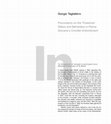
The Entombment of Christ, painted by Palma Giovane for the Oratorio dei Crociferi in Venice (1590... more The Entombment of Christ, painted by Palma Giovane for the Oratorio dei Crociferi in Venice (1590), contains the portraits of two Procurators of St Mark, whose unusual position at the back implicitly involves them directly in the sacred narrative. This article examines how the painting elaborates on typical strategies of Venetian institutional portraits to place the sitters on a threshold between fictive and real, and give them an intermediary function between the viewers and the scene. It argues that, by means of a well-thought design, the sitters spur the beholder, that is the destitute women of the adjoining hospice, to simultaneously worship Christ’s body and acknowledge the Procurators’ role as the administrators of the Oratory. The engagement with the spectator is thus exploited to symbolise the renewal of the endowment to the hospice through the ritual re-enactment of the Eucharistic mystery. While the past of the sacred narrative and the present of the spectator converge, the act of beholding formalises the relationship between those who are guarantors and those who are guarantees. Moreover, a replica of the painting, where a couple of anonymous donors have replaced the Procurators and pray before Christ, suggests that Palma’s painting was recognised as a model for social emulation, where the Procurators are acknowledged for their dignity.
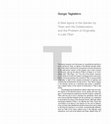
Throughout his career, and especially in the last three decades of his life, Titian issued from h... more Throughout his career, and especially in the last three decades of his life, Titian issued from his workshop a sizeable number of variants and replicas of different compositions. This vast circulation of paintings was boosted by a huge request from collectors across Europe, and helped Titian to establish himself as a widely celebrated artist. Over the years, the master developed an unconventional working method that privileged the unevenness of the pictorial surface over uniformity and homogeneity, thus emphasising the process of art-making. Indeed, it is especially for his peculiar, idiosyncratic handling of the brush that he was renowned, and his paintings sought after. Furthermore, this technique matched up with the cult of the personality that Titian himself fostered. At the same time, however, several of the variants and replicas produced in the late years raise the problem of how the collaboration with assistants affected the notion itself of authorship and originality. How did his innovative technique, which highlighted his virtuosity and individuality, harmonise with the documented, extensive contribution by his collaborators? Moreover, if each variant or replica received a unique, distinctive pictorial treatment, can we still draw a clear line between originals and derivations?
By presenting a previously unpublished version of Titian’s Agony in the Garden, whose composition is known through a painting executed for Philip II and now in the monastery of San Lorenzo del Escorial, this study seeks to discuss and establish a new theory of the nature of authorship in Titian’s late collaborative works. The new painting is here acknowledged as a joint work by the master and his collaborators, and stands as an example of how the novel aesthetics developed by Titian tolerated and perhaps even encouraged the incorporation of different hands into many of his late works.
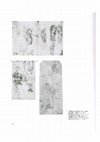
Bernard Aikema, Thomas Dalla Costa, Paola Marini (eds.), "Paolo Veronese: giornate di studio" (Venice: Lineadacqua-Fondazione Cini, 2016), pp. 102-113
Although scholars have praised Veronese’s interests in elevating drawing to a self-sufficient med... more Although scholars have praised Veronese’s interests in elevating drawing to a self-sufficient medium of expression, there have nonetheless been no explicit attempts to describe his draughtsmanship as an intellectually-engaged practice of the kind conceptualised by Vasari. It is my contention, instead, that Veronese’s corpus of drawings lends itself to be seen as the result of a constant, aware reflection upon the possibilities of representing human experience and behaviour. His work reveals a seemingly incessant exploration of the virtually unlimited expressive potential of the human figure, in poses, gestures, movements and interactions. This exploration is grounded in a ceaseless process of re-elaboration of recurring motifs and ideas that were sometimes reused, sometimes recast or recombined, and which could be adjusted to various subjects. While these drawings were undoubtedly helpful in workshop production, Veronese’s renderings operated as a particularly effective method of investigating visual forms in ever-changing contexts of meaning, and thus exceeded the standard function of being merely preparatory. In this article I argue that Veronese’s studies of figural gestures and postures evolved into an enquiry of the possible mental and moral attitudes of particular human beings in given circumstances, as described by specific narrative sequences.
in Aikema, B., and Marini, P. (eds.), Paolo Veronese: L’illusione della realtà, exh. cat. (Milan: Electa, 2014), pp. 164-172
Celebrazione e autocritica. La Serenissima e la ricerca dell’identità veneziana nel tardo Cinquecento, ed. by B. Paul (Roma, Viella), 2014, pp. 193-231, 2014
Studi Tizianeschi, Vol. 8 (2012), pp. 68-98, 2012
This article contains a compilation of all the documents concerning Titian’s son, Orazio Vecellio... more This article contains a compilation of all the documents concerning Titian’s son, Orazio Vecellio, introduced by an essay discussing his artistic and managerial activity within the family workshop. It contains 89 new documents, thus adding new material to that already published by the author in Le botteghe di Tiziano. The essay addresses the role played by Orazio in Titian’s later production, suggesting his was a regular and substantial contribution, while reattributing four paintings hitherto attributed to him to his cousin, Marco Vecellio. It ends by proposing new avenues of research into the social context in which the artist worked.
Venezia Cinquecento, Vol. 21 (2011), no. 41, pp. 107-161, 2012
Based on archival research, this article addresses Titian’s relationship with the Balbis: a middl... more Based on archival research, this article addresses Titian’s relationship with the Balbis: a middle-class Venetian family related to him, with whom he shared interests in the timber trade. It discloses connections between the artist and affluent circles of the Venetian bourgeoisie in the years 1550-70s, which included lawyers and members of the State bureaucracy, as well as shopkeepers and colour merchants connected with the Scuola della Carità. The analysis demonstrates both how this extended network was supported by Titian’s prestige, and how it fostered the artist’s social ambitions at the same time as his artistic activity.
Itinerari d’arte e storia tra le chiese oltre le mura di Castelfranco Veneto, a cura di G. Tagliaferro, Castelfranco Veneto, Liberali, 2011, pp. 37-42
Venezia Cinquecento, Vol. 18 (2008), no. 35, pp. 41-77, 2009
This article addresses Titian’s altarpiece of c. 1542-52 in the Duomo of Serravalle, near Treviso... more This article addresses Titian’s altarpiece of c. 1542-52 in the Duomo of Serravalle, near Treviso. It reconstructs the history of this painting by analysing new documents, and connects it to the painter’s commercial interests in the area. Analysing its quotation of Raphael’s cartoon of the Miraculous Draught of Fishes for the Sistine Chapel tapestries, the article advances a reading of the painting as a critique of the papacy, an interpretation it relates to Titian’s engagement with pope Paul III and the Farnese family, his promotion his son Pomponio to the clergy, and his proximity to the ‘spirituali’.

Venezia Cinquecento, Vol. 17 (2007), no. 34, pp. 77-102, 2008
: documenti e contesto per un gonfalone perduto 1. Contratto e contraenti La notizia di un accord... more : documenti e contesto per un gonfalone perduto 1. Contratto e contraenti La notizia di un accordo fra Emanuel Amberger e la Scuola dei Battuti di Serravalle per la realizzazione di un gonfalone dipinto, riferita al 24 agosto 1579, era stata segnalata marginalmente e in forma incompleta da Giovanni Tomasi, che nel suo volume sulla storia della Diocesi di Ceneda accennava a un documento esistente nel fonda della Scuola conservato nell'Archivio Storico Comunale di Vittorio Veneto, senza tuttavia riportarne l'esatta segnatura 1 . Sulla scorta di tale indicazione, un'approfondita ricerca nell'archivio vittoriese ha consentito di rinvenire, insieme alia ricevuta di pagamento menzionata da Tomasi ( ), che registra l'avvenuto versamento di una rata nella casa veneziana del pittore, anche l'atto contrattuale firmato a Serravalle dallo stesso Amberger e dai rappresentanti della Scuola davanti al notaio Francesco Ogniben il 23 agosto 1578 2 • Quest'ultimo reca in calce, alia data del 12 agosto 1580, la notifica del saldo conclusivo corrisposto al pittore, con sua piena soddisfazione ( . II contratto precisa che il "penello o vero confalon" avrebbe dovuto avere misure e soggetto identici a quelli del "confalon grande", raffigurante la Vergine e altre figure , rna superarlo in bellezza. Al pittore, cui veniva dato "per mostra" il modello originale, sarebbe toccata procurarsi il drappo di seta (cendal) , l'oro e i colori, cosl come ogni altro materiale necessaria all'esecuzione del manufatto, eccezion fatta per "le franze et cm·doni" che sarebbero stati forniti dalla confraternita. A gratifica del lavoro veniva pattuito un compenso di 70 ducati complessivi, 30 dei quali consegnati in acconto al momenta della stipula e 40 da liquidare alia conclusione dell'opera. Il termine di consegna, fissato al Natale successivo, venne abbondantemente oltrepassato: dopo la prima rata di 62 lire (corrispondenti a 10 ducati), pagata a un anno di distanza dalla convenzione, trascorsero infatti altri quattordici mesi prima della risoluzione finale. La consegna del denaro venne affidata in tale circostanza a Tommaso de Tommasi, che all'epoca era gastaldo del popolo della Scuola 3 , gia incaricato di andare a Venezia insieme al collega 77
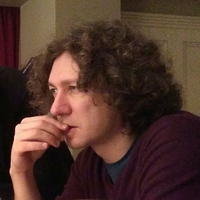


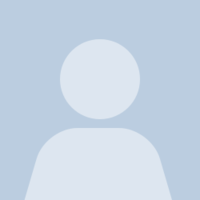







Uploads
Books by Giorgio Tagliaferro
Articles and essays by Giorgio Tagliaferro
By presenting a previously unpublished version of Titian’s Agony in the Garden, whose composition is known through a painting executed for Philip II and now in the monastery of San Lorenzo del Escorial, this study seeks to discuss and establish a new theory of the nature of authorship in Titian’s late collaborative works. The new painting is here acknowledged as a joint work by the master and his collaborators, and stands as an example of how the novel aesthetics developed by Titian tolerated and perhaps even encouraged the incorporation of different hands into many of his late works.
By presenting a previously unpublished version of Titian’s Agony in the Garden, whose composition is known through a painting executed for Philip II and now in the monastery of San Lorenzo del Escorial, this study seeks to discuss and establish a new theory of the nature of authorship in Titian’s late collaborative works. The new painting is here acknowledged as a joint work by the master and his collaborators, and stands as an example of how the novel aesthetics developed by Titian tolerated and perhaps even encouraged the incorporation of different hands into many of his late works.
A quattrocentocinquant’anni dalla battaglia di Lepanto, il seminario, curato da Serena Di Nepi e Massimo Moretti, si propone di riflettere su uno degli eventi più raccontati, rappresentati e celebrati del XVI secolo europeo.
L’assedio e il soccorso di Malta del 1565, come anche l’assedio di Cipro culminato con l’eccidio di Famagosta (1570-1571), furono gli eventi che sul piano della comunicazione guadagnarono l'interesse sempre maggiore di un vasto pubblico socialmente e culturalmente trasversale, rendendolo partecipe e attore della grande sfida antiturca rilanciata da Pio V con la chiamata alle armi dei principi cristiani.
Il seminario interdisciplinare, organizzato dal Dipartimento di Storia Antropologia Religioni Arte e Spettacolo,
intende presentare contestualmente e coralmente le parole, le immagini e le celebrazioni del grande evento militare nei palazzi nelle piazze e nei porti del Mediterraneo e il loro uso politico e ideologico nel tempo immediato e nel periodo successivo.
I relatori potranno ricostruire, attraverso fonti edite e inedite, lo sguardo singolare e collettivo sull’evento così come è stato vissuto, raccontato e rappresentato nei diversi spazi della politica e della società. L’intreccio di sguardi e metodologie, tra la storia e la storia dell’arte, sarà al centro dell’incontro e si tradurrà in un dialogo tra campi di ricerca e saperi. L’appuntamento si rivolge a dottorandi e laureandi di magistrale ed è organizzato con il sostegno del Dottorato di Ricerca in Storia, Antropologia, Religioni, del Dottorato di Ricerca in Storia dell’Europa e del Dottorato di Ricerca in Storia dell’Arte del Dipartimento SARAS
Towards the end of the sixteenth century, the Republic of Venice undertook a series of decorative campaigns that turned their administrative and executive headquarters, the Palazzo Ducale, into a powerful vehicle of political propaganda. Functioning as a junction between four of the most important state halls in the palace, the Room of the Four Doors regulated foot traffic and was walked through by a flux of people. This presentation will show how its decoration, formed of frescoes by the celebrated painter Jacopo Tintoretto as well as of stuccoes, represents one of the most significant and ambitious programmes of the Palazzo. With its emphasis on the liberty and nobility of the Venetian state and ruling class, it aimed to demonstrate how the once triumphant Republic was still on a level with the greatest European monarchies of the time.
La presa di Costantinopoli nel corso della Quarta Crociata (1204) ebbe non solo un impatto decisivo sulla politica e l’economia veneziane dell’epoca, ma anche ripercussioni di lunga durata sulle forme di autorappresentazione elaborate nei secoli successivi dalla Repubblica di San Marco. Questo intervento si focalizzerà sulla sequenza di dipinti raffiguranti la Quarta Crociata nella sala del Maggior Consiglio in Palazzo Ducale, realizzati a fine Cinquecento, e sul concomitante recupero delle relative fonti storiografiche, per dimostrare come a distanza di quasi quattrocento anni quegli eventi rappresentassero ancora un capitolo fondamentale nella costruzione del mito della Serenissima.
This seminar will discuss how Titian and Raphael, who arguably never met, developed at the same time and somewhat similarly, although in different cultural contexts and under different circumstances, innovative techniques and modes of representation to engage the viewers in new, more compelling ways. It will also highlight how Titian, still many years after Raphael’s death, looked to the late fellow artist not only as a source of inspiration for his extraordinary inventiveness and the supreme quality of his art, but also as an ideal of excellence to surpass, which spurred Titian to promote himself as the greatest of all artists, giving Venice its own ‘Raphael'.
In the 1510s Raphael was establishing himself as leading artist in papal Rome, creating iconic paintings that would enable his art to be regarded as a paragon of absolute beauty both by his contemporaries and in the centuries to come. Right in the same years, another talented painter rose to prominence in the republican city of Venice. Titian (ca. 1490-1576), who was slightly younger than Raphael and came from the mountains in the northern fringes of Venice’s inland, was soon to dominate the local artistic scene and extend his fame beyond the Italian peninsula, finally becoming one of the most celebrated masters of all times. Unlike Raphael, who died at age 37 in 1520, Titian lived a long life and career, during which he worked for numerous princes, furnishing their courts with a multitude of paintings that shaped the taste of European society and had a huge impact on artists from any latitude. Because of both his longevity and the sense of vigour and energy he imparted to his works, Titian’s art has been often compared to Michelangelo’s. The similarities between Titian and Raphael, on the contrary, have been largely underestimated, despite the fact that the two painters were revered as paradigms of artistic perfection until well into the nineteenth century. In today’s perception, the two artists are hardly, if any, conceived of in parallel terms, inasmuch as sixteenth-century Venice and Rome are seen as separate historical entities.
Sulla base di queste considerazioni generali, e attraverso un esame comparativo di disegni e dipinti realizzati in diverse fasi cronologiche, questo contributo intende dimostrare come, contrariamente all’ancora diffusa percezione di Veronese quale artista incolto e squisitamente esornativo, le sue composizioni posseggano viceversa un elevato livello di densità semantica, per lo più derivante da un’attenta elaborazione dei nessi strutturali che uniscono forma, funzione e soggetto. Individuando alcuni esempi significativi volti a illustrare alcuni aspetti chiave del processo creativo messo in pratica da Veronese, l’analisi metterà in evidenza la costruzione di un sistema binario su cui si erige un ben definito orizzonte morale tendente a contrapporre e giustapporre modelli comportamentali diversi, all’interno del quale si inquadrano l’azione e la caratterizzazione delle figure.
Daniel Wallace Maze (University of Iowa),
Giorgio Tagliaferro (University of Warwick).
Chair:
Maria H. Loh (Hunter College).
Presentations:
“Bellini and Mantegna, Bromance of the Renaissance”
Daniel Wallace Maze (University of Iowa);
“Friendship in Raphael's Self-Portrait with His Fencing Master”
Christian K. Kleinbub (Ohio State University);
“Michelangelo and Sebastiano: Friendship, Poetry, and Drawing”
Matthias Wivel (National Gallery, London).
Sunday, March 17, 2019, 4:00 PM - 5:30 PM, Sheraton Centre Toronto - Leaside.
This session intends to map out the shifting patterns and fragmented fortunes of the artistic workshops in the Italian Peninsula, emphasizing their role as the crossroads for artistic creation during the Early Modern period (ca. 1450-1650). We seek to explore the multifaceted identity of the artistic workshop, investigating its role in the production, transmission and circulation of practical and theoretical knowledge, as well as its function as a “social” environment promoting talent and creativity. The papers take into consideration the workshop as:
- a place for education and training;
- a hub for the creation of artistic networks;
- a production system and economic enterprise; - a connective link between artists and patrons; - a precursor of modern Art Academies.